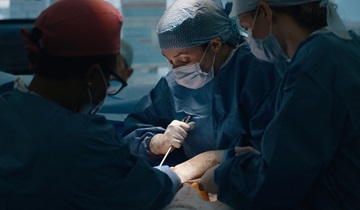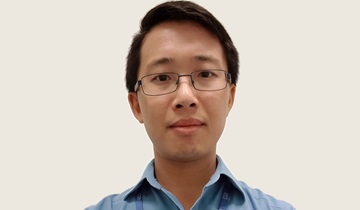Every second counts: saving lives at St Mary’s major trauma centre
Mr Kevin Tsang is head of specialty for major trauma at Imperial College Healthcare NHS Trust. The major trauma team features in the recent Netflix documentary series Critical: Between Life and Death, which examines London’s major trauma network. We spoke to Kevin about his role, the history of the network, and how mixed reality technology is improving surgical training.
What inspired you to work in this field?
I have always found the human body and the field of medicine fascinating, probably because I was unwell and had to see a range of doctors when I was little. But, also through reading stories about how surgeons can operate on someone and potentially rebuild their lives.
The skills required for this work suit my personality of forever seeking more knowledge about the wonders of the body. I went on to study at Guy’s and St Thomas’ hospitals and undertook neurosurgery training in south west England, before coming to Imperial College Healthcare NHS Trust as a consultant neurosurgeon.
I have always been drawn to the acute scenarios more than the planned elective operations. I guess this is just my personality. Even during my training, I would find any excuse to get involved in new trauma calls or any other acute admissions. As a result, I accumulated quite a lot of trauma experience and was employed at Imperial College Healthcare specifically as a craniofacial and spinal trauma specialist. I have continued to develop this skillset as a consultant and expanded into the field of craniofacial trauma. Over the past three years, I have also taken on the role as the major trauma head of specialty.

We are very proud of how the major trauma system is provided across London – of how people with such a wide range of specialties come together to ensure patients are looked after from the time of their accident all the way through to rehabilitation. We also have cross-site collaboration between the major trauma centres, something not showcased in the series, but which ensures a set standard across our centres.
For our Trust, I am so pleased to see Maryam Alfa-Wali, our trauma surgeon, featured in episode six. She is a very valued member of the team and represents our ethos – look after the patient and look after our staff by working collaboratively. I think this was very well captured in the documentary.
Is there anything you’d like viewers to take away from the documentary?
The most important thing really relates to teamwork. The patient cases featured in the series are all very complex and highly stressful for everyone involved. It is not possible to manage these complex cases by working in silo, both for patient safety and for the clinician’s own mental wellbeing.
In the series, you see multiple members of the teams working on patients simultaneously, often all doing slightly different things but ultimately contributing to the full package of care that the patients need. This does not usually require constant discussions between team members as everybody is already so well versed with their own role. The smooth running of the teams is so seamless that viewers may not even think about the fact that they are all complementing each other’s work. This is only possible when the team members all trust one another and are all experienced in what they do.
The major trauma centre at St Mary’s now has a full psychological support team, for patients and staff. What impact has this had?
This has been a huge project and a massive success. It is impossible to measure the positive impact for patients as well as their families through numbers. Major trauma often involves significant loss of function, changes to lifestyle or even loss of employment – not to mention potential loss of family members. The psychological impact is unimaginable and the availability of a team to support them is so important.
Although staff working in major trauma see these cases all the time and are trained in how to navigate this, we are of course still affected. All cases have the potential to make us feel certain ways. It is important that we are encouraged to talk about it, realise there are others in the same position and not feel so lonely.
How do you see trauma care evolving in the future, both at Imperial College Healthcare and in London?
Trauma care across London and specifically within north west London, has developed significantly over the past 15 years and is now a very smooth and efficient service. In fact, both our major trauma centre at St Mary’s Hospital and the North-West London Trauma Network have been awarded Outstanding at our latest peer review, led by NHS England.
There are of course still many things which can be done better. We constantly run audit and quality improvement projects to identify challenges and make sure we keep improving. One of the important things is to maintain a high level of training for all members of staff to ensure they are able to deal with any scenario. This can be achieved via simulation and we are developing numerous high-fidelity and in-situ simulation programmes to ensure high standards of care can be delivered every time.
Dr Kevin Tsang"We are working with engineers to develop a range of virtual, augmented and mixed reality software which can be used both for simulation and in practice to improve accuracy of certain operations."
We have purchased a surgical cut suit which can be worn by a volunteer to simulate trauma, allowing surgeons to simulate the actual operation on the person. We are also working with engineers to develop a range of virtual, augmented and mixed reality software which can be used both for simulation and in practice to improve accuracy of certain operations. The spinal team has also started using navigation and a robot to aid insertion of screws into the spine to avoid complications. These are examples of how we are applying advanced technology, not to take over the work, but to augment our abilities to ensure all interventions are delivered safely and effectively to every patient.
What are you most proud of from your time at the Trust so far?
I’m incredibly proud of the development of our multidisciplinary team within major trauma. Our team includes a wide range of healthcare professionals with different expertise and we aspire to a truly flat hierarchy. All members of the team have an equal say to contribute to the patient’s care, and we fully recognise that the service cannot run if we are missing any one profession.
Although consultants have ultimate responsibility for the patient’s care, our job is to listen to all the various opinions and information before making a joint decision, including the patient and family, for the best plan for each patient. No two patients are the same and therefore no two plans should be identical. Individualised medicine is only possible with a holistic approach and I am proud of how our multidisciplinary team has taken this to the next level.

The network was launched to reduce variation of care delivered across the country. It was clear that some form of standardised approach was needed to ensure that all patients, regardless of where they live, receive the highest standard of care. London paved the way as the first region to implement the system, with four networks set up across the region in 2010 – and linked together as the London major trauma network. This means that patients with specific needs (those requiring specialist care) will be taken to the right place efficiently, without the need for a secondary transfer which would waste valuable time to rescue the situation.
We now see many severely injured cases at the major trauma centre and, as our experience has built over the past 15 years, many patients facing complex multiple major traumas are now surviving with a good quality of life, something that would not have been possible just over a decade ago. The trauma units continue to play a vital role in treating single organ injuries to ensure efficient running of the system (otherwise the major trauma centre would be overwhelmed with workload) and the whole network has joint teaching, training and audit sessions to maintain the standard of care.
How do you switch off from work?
I’m very lucky to have a very supportive family who happily listen to me when I need a debrief on things which may have affected me. I rely heavily on them, as well as a strong social network, to keep a healthy balance between work and personal life. I enjoy a wide range of activities from outdoor sports to indoor board and video games, all of which help me switch off. But my favourite activity is probably just sitting down with a bit of background music and writing stories. This helps to switch my mind from logical thought processes to a more creative nature.
- Feeling inspired? Start your career at our Trust.
- Watch the trailer for Netflix's Critical: Between Life and Death.
